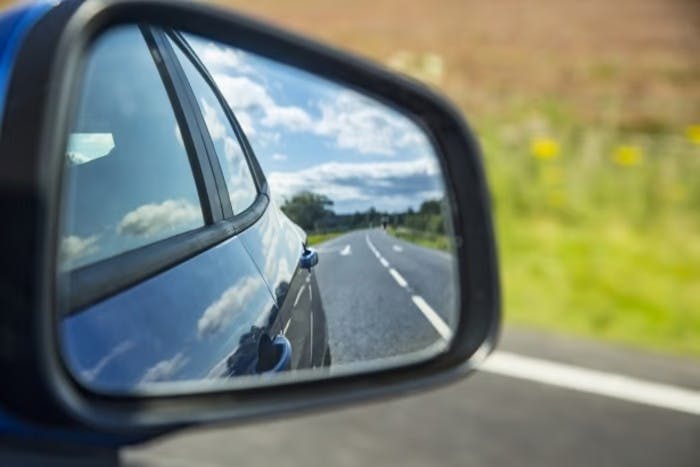
Ever since the driving test changed in 2017, candidates are no longer expected to demonstrate the turn in the road manoeuvre (otherwise known as a three point turn) during their practical test. In day-to-day driving, however, this manoeuvre remains as relevant as ever, and being able to perform it well is crucial. So, if you're looking to become a pro at this manoeuvre, we've got just the thing for you!
This manoeuvre guide will walk you through the turn in the road: how to actually complete it, what an examiner would be looking for were it still on the test, and when you might need to use it in real-life conditions.
What is the turn in the road manoeuvre?
The turn in the road manoeuvre enables drivers to, as the name suggests, turn their vehicle around in the road. It's a method, much like reversing around a corner, which drivers can use to manoeuvre their vehicle to face the opposite direction if they're on a road that's too narrow for a U turn. With most drivers able to complete the manoeuvre in three moves, it is also commonly referred to as a “three point turn”.
Typical instructions from an instructor or examiner for this manoeuvre would be something along these lines:
“When it's safe to do so, would you please pull up on the left? Then I'd like you to turn the vehicle around to fact the opposite direction in as few moves as possible. Move off when you are ready.”
Before the driving test changes in 2017, turn in the road was one of four manoeuvres that learners might have been expected to demonstrate during their practical. Along with the reversing around a corner manoeuvre, turn in the road was taken off the list in favour of pulling up on the right. Please note, this does not mean you should neglect to learn how to turn in the road—instructors should still be teaching it.
What is the examiner looking for?
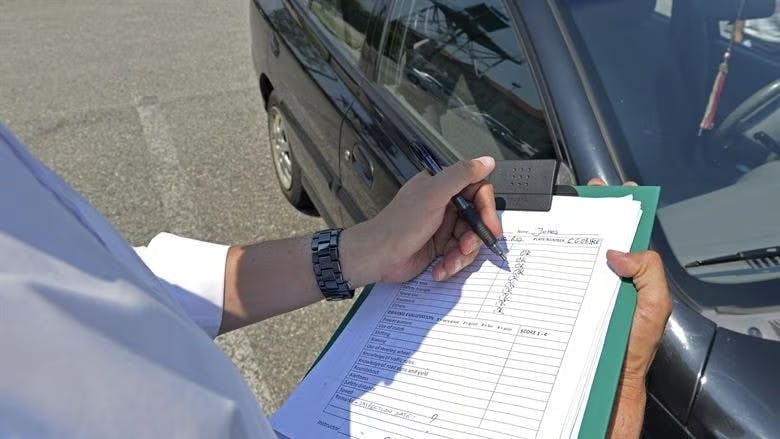
Though the turn in the road manoeuvre no longer features on the practical test, we still have information on what examiners looked for when it was a requirement. Following these guidelines should help you not to simply complete the manoeuvre, but to carry it out to a high standard.
During the old driving test, the examiner would be keeping a close eye on your coordination of controls. To successfully execute a turn in the road, after all, you'll need to combine the careful use of your clutch with swift and controlled steering. Meanwhile, you'd also need to have displayed awareness of your surroundings, completing frequent observations in order to keep on top of oncoming traffic, cyclists and pedestrians.
You would have also been expected to demonstrate:
- Accuracy: whilst it's not always possible to complete a turn in the road in three moves, you'd be expected to do it in five moves or less.
- Control: you need to have a firm control of your clutch and speed—slow and steady is key here. You also need to take care to avoid mounting or hitting the kerb.
- MSM: as with any other manoeuvre or action on the road, constant all-around checks are key.
There are a few key things you need to ask yourself when thinking about completing a turn in the road manoeuvre:
- Is it safe and legal to do so on the road you're on?
- Do you have enough room to complete the manoeuvre?
- Is it safe to do so based on the volume of traffic?
Obviously, you should not attempt this manoeuvre on a main road. If you're not 100% certain you can complete a turn in the road safely, you should instead opt for reversing around a corner.
Step-by-step: How do I complete a turn in the road?
And now onto the fun part: learning how to complete a turn in the road! We're going to break it down into four separate parts in order to make it easier to follow—things always seem more doable when they're broken down into smaller parts. Of course, you might find that you won't need so many steps when completing it in real life.
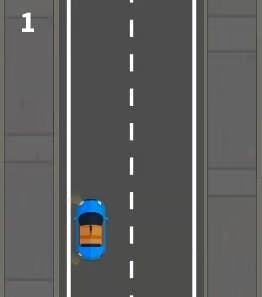
1. Stop on the left
You'll begin the turn in the road manoeuvre by parking on the left-hand side of the road. Whilst this might sound straightforward, it's absolutely vital that you carefully consider where you're going to stop your car. You shouldn't ever rush yourself when picking a safe location to park up at—if you don't think it through properly, you might end up disrupting the flow of traffic or, worse still, injuring someone in the process.
- As you're driving, keep your eye out for a safe location for you to pull up on the left. Try to avoid parking on someone's driveway, opposite a junction or on a sharp bend—trust us, it will make your life easier!
- Before you even think about pulling up, you need to check both your interior mirror and your left-hand mirror. You need to closely monitor the flow of oncoming traffic and ensure it's safe for you to move.
- Sure it's clear and safe for you to pull up? Great. Give your mirrors another check before you signal left and pull up. If it's a particularly tight road, make sure you don't pull up across from other parked vehicles—it will make it impossible to manoeuvre.
- Once you've stopped the car, apply your handbrake and select neutral. Don't forget to cancel your indicators too.
2. Steer to the right
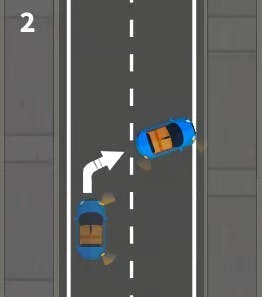
One of the most important things you need to remember with the turn in the road manoeuvre is that you should only start it once you're sure the road is clear. If you don't wait until it's clear, you'll end up holding up traffic until you're done—if you didn't feel the pressure before you started, you definitely would with dozens of drivers beeping at you to hurry up!
- Before you start anything, take a look at your interior mirror, your right-hand mirror and then turn to look at your right blindspot. If you see any oncoming traffic, cyclists or pedestrians, halt your movements before you're sure it's clear.
- Start off by signalling right and begin moving very slowly by making careful use of your clutch. Remember, slow and steady is key, so keep it at a snail's pace. After moving forward, steer quickly a full lock to the right.
- Once you're around 1m from the kerb, you need to turn the wheel once to the left. Still not 100% with measuring distances? Your instructor should be able to offer you a reference point to use for the turn in a road manoeuvre.
- As you're moving, keep glancing at your mirrors and blindspots for oncoming traffic. After you complete the left turn, stop the car, apply your handbrake and then select the reverse gear.
3. Reverse slowly
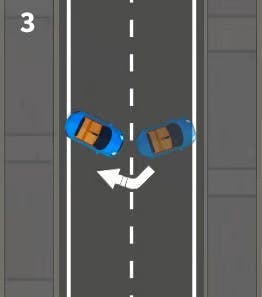
It's now time to start the reversing section of the turn in the road manoeuvre. Don't forget your observations—reversing is dangerous if you're not attentive to what's going on around you.
- As you did when you started the manoeuvre, you need to check carefully for any oncoming traffic—check both sides of the road, making use of your mirrors and double-checking your blindspots.
- With this being a reversing manoeuvre, you'll obviously need to keep a close eye on your rear windscreen. Use your clutch and slowly start to move your vehicle backwards. At the same time, steer quickly with a full left lock.
- Now it's time for you to look over your right shoulder at the kerb behind you. It's vital that you keep to a slow speed here—you don't want to move too quickly and end up hitting the kerb.
- Once you're around 1m from the kerb, again, steer once to the right and then use your clutch and brake pedals to stop your vehicle.
4. Move off
You're now only one move away from completing the turn in the road manoeuvre successfully!
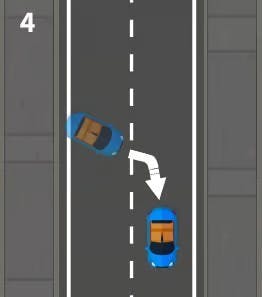
- Again, you shouldn't proceed with anything until you're absolutely sure that there's no oncoming traffic—check both sides of the road before you start moving.
- You'll need to complete mirror and blindspot checks at this point. It will help if you do it in a clockwise movement—looking over your left shoulder blindspot, left-hand mirror, interior, right-hand mirror, right shoulder blindspot and then the rear window.
- Then, you can select the first gear and find your clutch's biting point. Once clear, disengage your handbrake and, keeping the car at a slow speed, steer quickly to the right.
- You've now made it to the other side of the road facing the opposite direction of where you first started. After checking it's clear—using your right-hand mirror and interior mirror—you can move off.
Congratulations—you've gotten to the end of the step-by-step process of the turn in the road manoeuvre.
Now, whilst this guide shows you how to do it in three moves—a literal 3 point turn—it's important that you're aware that you can use as many moves as you'd like to complete it. If you're a beginner, it might take you longer to adjust to it. Once you've got more experience under your belt, you'll probably be able to do it without breaking a sweat!
When would this be used in real life?
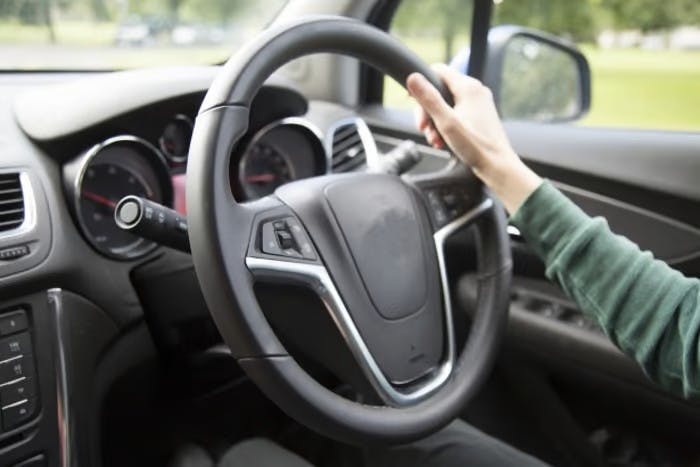
You'd be pretty hard pressed to find many drivers in the UK who haven't ever had to turn around and change directions whilst out on the road. Whether you've come to the realisation that you've taken a wrong turn, or the road ahead is obstructed, or you're looking at joining a heavy stream of traffic in for a long wait, knowing what to do to change direction is essential.
If you're in this type of situation on the roads, and you're unable to do a U turn—many roads in the UK aren't wide enough for this—then a turn in the road (three point turn) might be your only option for turning around. In just a few simple moves, you can avoid going the wrong way and drive back the way you came. Of course, if you've not got enough room for this manoeuvre, you'll want to opt for reversing around a corner or continuing on to a side road instead.
FAQs
1. Will the turn in the road manoeuvre be on my driving test?
Nope. You don't have to worry about turn in the road showing up on your test. Ever since the driving test changes introduced in 2017, it has been removed from the practical test, along with reversing around the corner.
2. Do I really need to know how to turn in the road, then?
As we've discussed in our section on “when would this be used in real life?”, a turn in the road is a top solution to changing direction on the road when you're unable to complete a U turn. As such, it's important that you know how to do it. Not tried it yet? Your instructor will teach you how to perform it safely.
3. Which manoeuvres will show up on my test?
Whilst the turn in the road manoeuvre won't show up on your test, you will be expected to demonstrate one of the three following manoeuvres instead:
- Bay parking—either reversing into a parking space and out, or driving into a parking space and reversing out
- Pulling up on the right, reversing two car lengths and rejoining the traffic
- Parallel parking at the side of the road
4. Is it legal to turn in the road?
As with most manoeuvres, yes, within reason. Firstly, you shouldn't bother attempting a turn in the road on a main road—it's unlikely it would stay clear long enough for you to complete the manoeuvre. In this type of scenario, you're better off finding somewhere else to safely turn around, e.g., a side road.
5. Does it have to be completed in three point?
Nope. Despite its other commonly used name—three point turn—the turn in the road manoeuvre does not have to be completed in three moves. When the manoeuvre was part of the driving test, you were allowed up to five moves. In real life, of course, you're not limited to a certain number of moves. If you find you need to use five moves or more whenever you complete the manoeuvre, you might want to look into practising with a driving instructor to refine your skills.
6. What do I do if there's a lot of oncoming traffic?
Real life driving is unpredictable, so there's no real way to fully prepare for what might happen on the road. As such, it's mostly up to you to make the safest decision. A turn in the road could take you as little as one minute to complete, or as long as five minutes. If you don't think the roads will stay clear long enough, you might have to continue driving and turn into a side road, for example.
7. What happens if another car comes up behind me?
If you've already started the turn in the road when a vehicle shows up behind you, you don't really have any choice but to continue. Unless there's space for the other vehicle to manoeuvre past you, they have no way of getting by. If this happens, don't rush. Take your time and continue on as safely as possible. Don't worry about the other driver—they'll understand.
8. Do I have to signal for a turn in the road?
Signalling is vital on the road for helping other road users figure out what you intend to do—remember MSM! If you're driving down the road and stop suddenly, other road users aren't going to automatically assume you're turning around. As such, you should signal right to let them know you intend to turn.
9. What distance should I be from the kerb during this manoeuvre?
As our directions state, the closest your vehicle should get to the kerb is within approximately 1 metre. When you learn how to perform this manoeuvre with your instructor, they'll teach you reference points and help you figure out how to gauge distances from the car you're driving in.
10. What if I think I'm going to hit the kerb?
If you take things slowly enough during a manoeuvre, you should be able to stop things before anything dangerous occurs. If, at any point, you feel like you're close to hitting the kerb, stop what you're doing and readjust—don't just wait for something bad to happen first. Part of what makes a good driver is spotting potential hazards and making necessary adjustments to avoid them.
Subscribe for driving advice, offers & more
We'd love to let you know about our courses, news and offers via email. You may unsubscribe at any time.
Star Genie Limited trading as PassMeFast. Company number 10093359
Copyright © 2024 owned by Star Genie Limited
PassMeFast, Blue Tower, MediaCityUK, Salford, M50 2ST

